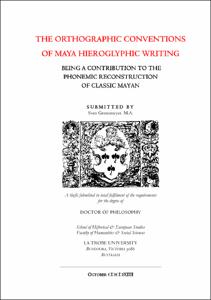Gronemeyer, Sven: The Orthographic Conventions of Maya Hieroglyphic Writing : Being a Contribution to the Phonemic Reconstruction of Classic Mayan. - Melbourne, 2014. - , .
Online-Ausgabe in bonndoc: https://hdl.handle.net/20.500.11811/1115
Online-Ausgabe in bonndoc: https://hdl.handle.net/20.500.11811/1115
@phdthesis{handle:20.500.11811/1115,
author = {{Sven Gronemeyer}},
title = {The Orthographic Conventions of Maya Hieroglyphic Writing : Being a Contribution to the Phonemic Reconstruction of Classic Mayan},
school = {},
year = 2014,
note = {This study investigates the orthography of Maya writing on an empirical and statistical basis. It restricts itself to the realisation of certain grammatical morphemes that are selected as representative showcases. Furthermore, the question of spelling alternations at the morphemic boundary between the root and grammatical suffixes are investigated. The process of re-transferring the epigraphically attested grapheme string back into a phoneme string has proven to be an ambiguous process. A statistical assessment of the underlying representational rules for grammatical suffixes needs to consider both phonology and function. The epigraphic evidence is therefore first viewed against the linguistic data of relevant Mayan languages and before the background of historical linguistics. Based on previous epigraphic research, hypotheses can be formulated, how these grammatical forms can be represented in writing. With this knowledge, samples are gathered from the hieroglyphic corpus. These samples are subject to a three-tier analytical process: (1) linguistic analysis and attribution with analytical parameters in a data base, (2) significance tests for spelling patterns and other methods from quantitative linguistics, and (3) discussion of the test results against the linguistic hypotheses. The tests largely confirm specific orthographic rules in a variety of environments. The rules also provide an important contribution to the vocalisation of grammatical suffixes and therefore to the pronunciation of the Classic Mayan language. The specification of standard patterns also enables a better explanations of deviations. Thus, more light can be shed on a large range of aspects: (1) language genealogy and geography, (2) vernacular influences, (3) socio-linguistics, or (4) scribal schools, to name only a few. More confidence in a standardised Classic Mayan orthography also fosters increased trust in the vocalisation of the language and ultimately more confidence to more correctly read and interpret hieroglyphic texts. It is one step towards a consolidated grammar of Classic Mayan.},
url = {https://hdl.handle.net/20.500.11811/1115}
}
author = {{Sven Gronemeyer}},
title = {The Orthographic Conventions of Maya Hieroglyphic Writing : Being a Contribution to the Phonemic Reconstruction of Classic Mayan},
school = {},
year = 2014,
note = {This study investigates the orthography of Maya writing on an empirical and statistical basis. It restricts itself to the realisation of certain grammatical morphemes that are selected as representative showcases. Furthermore, the question of spelling alternations at the morphemic boundary between the root and grammatical suffixes are investigated. The process of re-transferring the epigraphically attested grapheme string back into a phoneme string has proven to be an ambiguous process. A statistical assessment of the underlying representational rules for grammatical suffixes needs to consider both phonology and function. The epigraphic evidence is therefore first viewed against the linguistic data of relevant Mayan languages and before the background of historical linguistics. Based on previous epigraphic research, hypotheses can be formulated, how these grammatical forms can be represented in writing. With this knowledge, samples are gathered from the hieroglyphic corpus. These samples are subject to a three-tier analytical process: (1) linguistic analysis and attribution with analytical parameters in a data base, (2) significance tests for spelling patterns and other methods from quantitative linguistics, and (3) discussion of the test results against the linguistic hypotheses. The tests largely confirm specific orthographic rules in a variety of environments. The rules also provide an important contribution to the vocalisation of grammatical suffixes and therefore to the pronunciation of the Classic Mayan language. The specification of standard patterns also enables a better explanations of deviations. Thus, more light can be shed on a large range of aspects: (1) language genealogy and geography, (2) vernacular influences, (3) socio-linguistics, or (4) scribal schools, to name only a few. More confidence in a standardised Classic Mayan orthography also fosters increased trust in the vocalisation of the language and ultimately more confidence to more correctly read and interpret hieroglyphic texts. It is one step towards a consolidated grammar of Classic Mayan.},
url = {https://hdl.handle.net/20.500.11811/1115}
}






